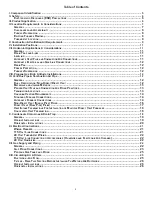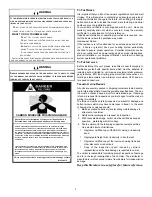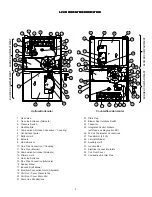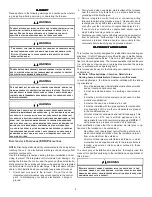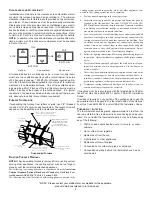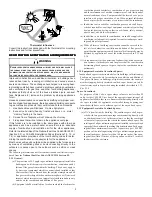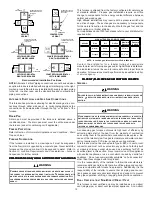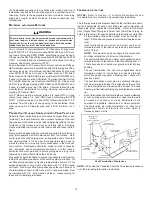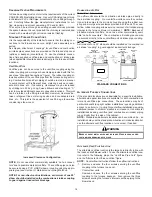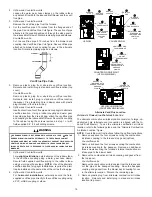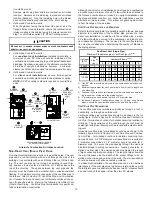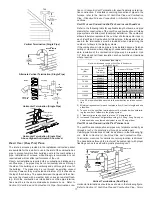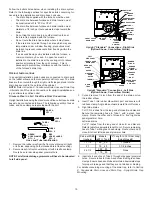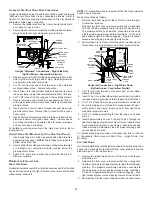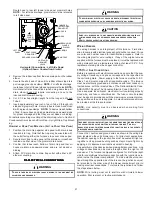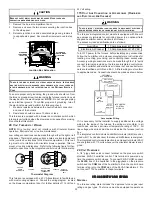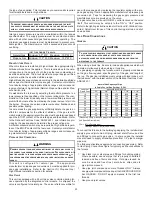
8
venting system placed in operation, while any other appliances con-
nected to the venting system are not in operation:
a. Seal any unused openings in the venting system;
b. Inspect the venting system for proper size and horizontal pitch, as
required by the National Fuel Gas Code, ANSI Z223.1 or the CSA
B149 Installation Codes and these instructions. Determine that there
is no blockage or restriction, leakage, corrosion and other deficien-
cies which could cause an unsafe condition;
c. In so far as practical, close all building doors and windows and all
doors between the space in which the appliance(s) connected to the
venting system are located and other spaces of the building. Turn
on clothes dryers and any appliance not connected to the venting
system. Turn on any exhaust fans, such as range hoods and bath-
room exhausts, so they shall operate at maximum speed. Do not
operate a summer exhaust fan. Close fireplace dampers;
d. Follow the lighting instructions. Place the appliance being inspected
in operation. Adjust thermostat so appliance shall operate continu-
ously;
e. Test for draft hood equipped spillage at the draft hood relief open-
ing after 5 minutes of main burner operation. Use the flame of a
match or candle;
f.
After it has been determined that each appliance connected to the
venting system properly vents when tested as outlined above, re-
turn doors, windows, exhaust fans, fireplace dampers and any other
gas burning appliance to their previous conditions of use;
g. If improper venting is observed during any of the above tests, the
common venting system must be corrected.
Corrections must be in accordance with the latest edition of the Na-
tional Fuel Gas Code ANSI Z223.1 and/or CSA B149 Installation
Codes.
If resizing is required on any portion of the venting system, use the
appropriate table in Appendix G in the latest edition of the National
Fuel Gas Code ANSI Z223.1 and/or CSA B149 Installation Codes.
T
HERMOSTAT
L
OCATION
The thermostat should be placed approximately five feet fom the
floor on a vibration-free, inside wall in an area having good air circu-
lation. Do not install the thermostat where it may be influenced by
any of the following:
•
Drafts, or dead spots behind doors, in corners, or under
cabinets.
•
Hot or cold air from registers.
•
Radiant heat from the sun.
•
Light fixtures or other appliances.
•
Radiant heat from a fireplace.
•
Concealed hot or cold water pipes, or chimneys.
•
Unconditioned areas behind the thermostat, such as an
outside wall.
C
LEARANCES
AND
A
CCESSIBILITY
Installations must adhere to the clearances to combustible materi-
als which this furnace has been design certified to. The minimum
clearance information for this furnace is provided on the unit’s clear-
ance label. These clearances must be permanently maintained.
Clearances must also accommodate an installation’s gas, electri-
cal, and drain trap and drain line connections. If the alternate com-
bustion air intake or vent/flue connections are used additional clear-
ance must be provided to accommodate these connections. Refer
to
Section IX, Vent Flue Pipe and Combustion Air Pipe
for details.
NOTE:
In addition to the required clearances to combustible mate-
rials, a minimum of 24 inches service clearance must be available
in front of the unit.
T O P
B O T T O M
S ID E
S ID E
S ID E
T O P
B O T TO M
U p flo w
C o u nte rflo w
H o riz on ta l
A furnace installed in a confined space (i.e., a closet or utility room)
must have two ventilation openings with a total minimum free area
of 0.25 square inches per 1,000 BTU/hr of furnace input rating. Re-
fer to the Product Data Book applicable to your model* for minimum
clearances to combustible surfaces. One of the ventilation open-
ings must be within 12 inches of the top; the other opening must be
within 12 inches of the bottom of the confined space. In a typical
construction, the clearance between the door and door frame is usu-
ally adequate to satisfy this ventilation requirement.
F
URNACE
S
USPENSION
If suspending the furnace from rafters or joists, use 3/8" threaded
rod and 2”x2”x1/8” angle iron as shown below. The length of rod will
depend on the application and the clearances necessary.
TILT OUTWARD TO ALLOW FOR
DOOR AND CIRCULATOR BLOWER
REMOVAL
3/8" DIAMETER
THREADED ROD
(6 PLACES)
PROVIDE 8" MINMUM CLEARANCE BETWEEN
CENTER ROD AND FURNACE CABINET
TO ALLOW FOR CIRCULATOR BLOWER REMOVAL
ASSURE FURNACE IS LEVEL FROM
END TO END AND HAS A SLIGHT
FORWARD TILT WITH THE FRONT
OF THE FURNACE 0"-3/4"
BELOW THE BACK OF THE FURNACE
POSITION AS CLOSE AS POSSIBLE
TO BLOWER DECK TO ALLOW FOR
CIRCULATOR BLOWER REMVOAL
2"
X
2"
X
1/8"
ANGLE IRON
(3 PLACES)
HOLD DOWN
NUTS
SUPPORT
NUTS
Suspended Furnace
E
XISTING
F
URNACE
R
EMOVAL
NOTE:
When an existing furnace is removed from a venting system
serving other appliances,
the venting system may be too large to
properly vent the remaining attached appliances.
The following vent testing procedure is reproduced from the
American
National Standard/National Standard of Canada for Gas-Fired Cen-
tral Furnaces ANSI Z21.47·CSA-2.3 Section 1.23.1.
The following steps shall be followed with each appliance connected to the
*NOTE: Please contact your distributor or our website for the applicable
product data book referred to in this manual.


